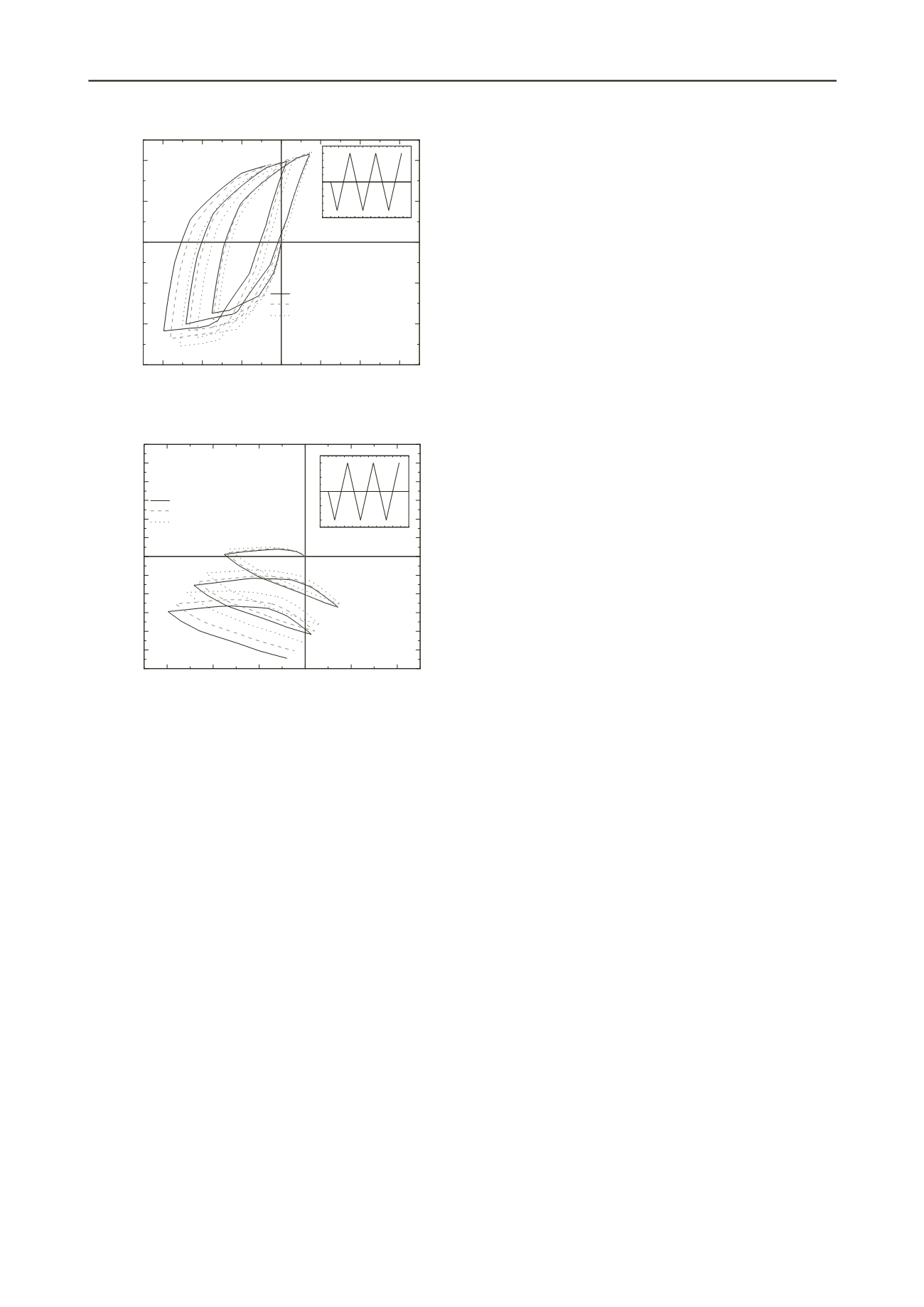
804
Proceedings of the 18
th
International Conference on Soil Mechanics and Geotechnical Engineering, Paris 2013
-1.5
-1.0
-0.5
0.0
0.5
1.0
1.5
-0.6
-0.4
-0.2
0.0
0.2
0.4
Very slow loading rate
High loading rate active only on
2
High loading rate active on all
1
-
6
-50 0 50 100 150 200 250 300 350 400 450 500
-0.04
-0.02
0.00
0.02
0.04
Displacements, cm
Pseudo time
Symmetric Modulus
Initial anisotropy
Elasto-visco-plastic solution
Sin(
)
Shear strain,
=
1
-
3
(%)
Figure 3. Fixed amplitude cyclic loading simulation showing
-1.5
-1.0
-0.5
0.0
0.5
1.0
-1.2
-1.0
-0.8
-0.6
-0.4
-0.2
0.0
0.2
0.4
0.6
0.8
1.0
1.2
Very slow loading rate
High loading rate active only on
2
High loading rate active on all
1
-
6
Symmetric Modulus
Initial anisotropy
Elasto-visco-plastic solution
-50 0 50 100 150 200 250 300 350 400 450 500
-0.04
-0.02
0.00
0.02
0.04
Displacements, cm
Pseudo time
v
1 3
Shear strain,
=
1
-
3
(%)
Volumetric strain
=
+
(%)
the variation of Sin(
) versus Shear strain,
.
Figure 4. Fixed amplitude cyclic loading simulation showing the
variation of Volumetric strain,
v
versus Shear strain,
.
6 ANALYSIS AND RESULTS
A fixed amplitude displacement control analysis has been
carried out by using dynamic relaxation. There were a total of
10 yield surface nested concentrically as shown in Figure 2. The
yield surfaces were activated one after another. The activation
of an yield surface is decided by the proximity tolerance
(f=0.0001). When two consecutive yield surfaces yields due to
loading and difference between them becomes less than the
tolerance, then the larger aperture yield surface is activated. In
Figure 2, the currently active yield surface is designated by red
color. The model is integrated through a return mapping
algorithm. The determination of exact value of proximity
.
Figure 3 and 4.
Three type of analysis are carried out in this research. First
an ysis was very slow loading analysis, showed in black
colored slid line. The other two analyses are carried out at
ij
).
7
and and
their constitutive modeling”, Soils and Foundations, Vol. 42,
ddiquee, M. S. A., Ahmad, S. I., 2007,
Mo
a multi-surface kinematic hardening plasticity and its
Plasticity 21, 1741-1770.
of integration algorithms for elastoplastic constitutive relations,
for Numerical Methods in Engineering,
tolerance is a limitation to this implementation
The results of the analysis are shown in
al
higher speed of loading. It has en found that viscous effect of
loading rate is pronounced much when the viscous formulation
is based on all components of initial shear angles (
be
CONCLUSIONS
A visco-elasto-plastic multi-surface model is developed for
cyclic loading. In this research, the original model is extended
to include the effect of rate of loading. The integration of
incremental elasto-plastic equation is carried out by steepest
descent return mapping algorithm.The dilatancy of dense sand
has been modeled using non-associated flow rule via direct
inclusion of Row’s stress-dilatancy relationship.
3. ACKNOWLEDGEMENTS
The authors wish to thank Professor Fumio Tatsuoka for
allowing the authors to use the viscous three component model.
4. REFERENCES
Di Benedetto,H., Tatsuoka,F. and Ishihara,M. (2002),
“Time-dependent shear deformation characteristics of s
No.2, pp.1-22.
Hossain, M. R., Si
deling nonlinear stress-strainrelations of materials, 6th
International Symposium on New Technologies for Urban
Safety of Mega Cities in Asia, Dhaka, 2007 (CD-ROM)
Hossain, M.R., Siddiquee, M.S.A, Tatsuoka, F, 2005,
“Development Of A Cyclic Model For Pressure Insensitive
Soil”, Proceedings of the Japan Bangladesh Joint Seminar on
Advances in Bridge Engineering, August, 2005, Dhaka
Khoei, A.R. and Jamali N., 2005, On the implementation of
applications, International Journal of
Mróz, Z., 1967, On the Description of Anisotropic
Workhardening,
J. Mech. Phys. Solids
,
15,
163.
Ortiz, M. And Simo, J. C., 1986, An analysis of a new class
International Journal
Vol. 23, pp.353-366
Prager, W., 1956, A New Method of Analyzing Stresses and
Strains in Work Hardening Plastic Solids,
J. Appl. Mech.
,
23
,
795- 810.
Prevost, J. H., 1985, A simple plasticity theory for frictional
cohesionless soils, Soil Dynamics and Earthquake Engineering,
4(1), 9-17.
Siddiquee, M. S. A., Tanaka, T. and Tatsuoka F., 1996,
Tracing the equilibrium path by Dynamic Relaxation in
materially nonlinear problems, International Journal of
Numerical Analysis Methods in Geomechanics, Vol. 19, pp.
749-767.
Siddiquee,M.S.A., Tanaka,T., Tatsuoka,F., Tani,K. and
Morimoto,T., 1999, FEM simulation of scale effect in bearing
capacity of strip footing on sand, Soils and Foundations, Vol.39,
No.4, pp.91-109.
Siddiquee, M. S. A., Tatsuoka, F., Tanaka, T. , Tani, K.,
Yoshida, K. and Morimoto, T., 2001a; Model tests and FEM
simulation of some factors affecting the bearing capacity of
footing on sand, Soils and Foundations, Vol.41, No.2, pp.53-76.
Siddiquee, M. S. A. and Tatsuoka, F., 2001b, Modeling
time-dependent stress-strain behaviour of stiff geomaterials and
its applications, Proc. 10th International Conference on
Computer Methods and Advances in Geomechanics
(IACMAG), Tucson, Arizona on January 7-12.
Siddiquee, M. S. A., Tatsuoka, F. and Tanaka, T., 2006,
FEM simulation of the viscous effects on the stress-strain
behaviour of sand in plane strain compression, Soils and
Foundations, Vol. 46, No. 1, 99—108.
Suklje, L. 1969, Rheological aspects of soil mechanics,
Wiley-Interscience, London.5
Tatsuoka, F., Siddiquee, M. S. A., Park, C. S., Sakamoto, M.
and Abe, F., 1993, Modeling stress-strain relations of sand,
Soils and Foundations,
Vol.
33,
No. 2, 60-81, June.
Tatsuoka,F., Ishihara,M., Di Benedetto,H. and Kuwano,R.
2002, Time-dependent shear deformation characteristics of
geomaterials and their simulation, Soils and Foundations, Vol.
42, No.2, pp.103-129.
Tatsuoka, F., Masuda, T., Siddiquee, M. S. A. and Koseki, J.
2003, “Modeling the stress strain relations of sand in cyclic
plane strain loading”, Journal of Geotechnical and
Geoenvironmental Engineering, ASCE, May.


